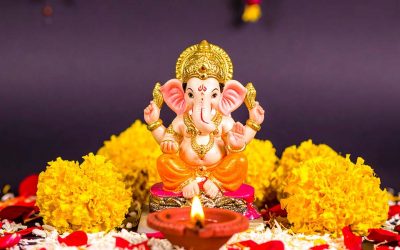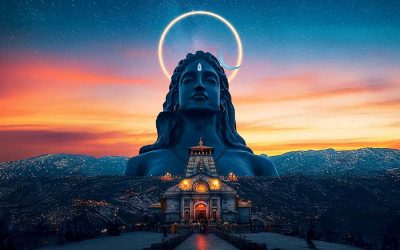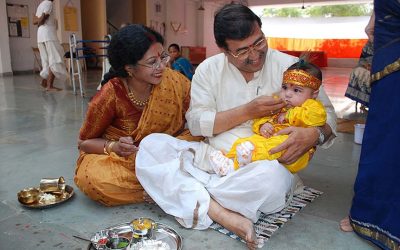Discovering the Meenakshi Temple in The Heart of Madurai’s Spiritual Landscape
The stunning Meenakshi Temple is deep within the heart of Tamil Nadu, in the vibrant city of Madurai. A religious monument in the cultural tapestry of India, Meenakshi Temple attracts pilgrims and tourists from all over the world. The legend of Meenakshi (an incarnation of goddess Parvati) and Sundareswarar (an incarnation of Lord Shiva) is a part of the very essence of Madurai’s history. It dates back to as early as the 4th century CE.
The Legend of Meenakshi
The Meenakshi Temple’s story starts from the intriguing myth of Goddess Meenakshi, an incarnation of Parvati, and Lord Sundareswarar, a form of Shiva. It has be told that King Malayadwaja and his queen, Kanchanamalai performed a sacred ritual to have a son to inherit the throne. But instead, they were presented with a three-year-old girl with three breasts emerging from the consecrated fire. There was a divine voice reassuring the king and queen that the third breast would disappear when the princess met her rightful consort. The girl was named Meenakshi and grew up to be a fierce princess. During her fight in Mount Kailash, she met Shiva in the battle. At the sight of him, her third breast disappeared, leaving her to realize that Shiva was her divine consort. Their celestial wedding, celebrated every year as the “Meenakshi Thirukalyanam,” attracts thousands and is celebrated with pomp and jubilation, one of the temple’s biggest occasions.
Architectural Grandeur and Artistic Brilliance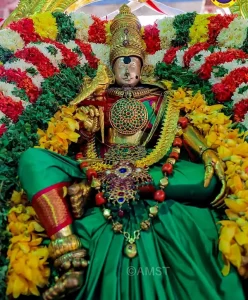
The existing structure of the Meenakshi Temple, rebuilt extensively between the 16th and 17th centuries, is a huge complex contained within huge walls and accessed through towering gopuras (gateway towers). These gopuras, with an elaborate series of gods, goddesses, and mythological creatures painted in vivid colours, are a testament to the Tamil craftsmen’s skill.
At the centre of the temple complex are the twin shrines of Meenakshi and Sundareswarar, surrounded by a series of mandapas (halls) and minor shrines. The most impressive of them is the Aiyaram Kal Mandapa (Thousand-Pillar Hall), which, despite its name, contains 985 elegantly carved pillars. Each pillar supports an elaborate statue, narrating scenes from ancient texts, adding to the temple’s awe-inspiring beauty.
A Living Sanctuary
The Meenakshi Temple is an ancient relic and a living reminder of ongoing spiritual practice. Daily rituals, vibrant hymns, and ritual processions bring the temple to life. The Golden Lotus Pond in the temple, where pilgrims cleanse themselves before worship, offers a note of serenity amidst the temple’s frenetic activity.
The Significance of the Temple
Inside the temple, we have both Shaiva and Vaishnava deities, making it a significant site for both sects. As a symbol of unity, the Meenakshi Temple brings together different strands of Hinduism. The presence of Vishnu as the brother of Meenakshi in the temple mythology emphasises the temple’s unifying role between the different religion beliefs within Hinduism.
A Melting Pot of Culture
The temple goes beyond religious boundaries, playing an essential role in the cultural and economic life of Madurai. It sustains a vast network of artisans, florists, musicians, and shopkeepers whose livelihood is irrevocably linked with the prosperity of the temple. The temple is brought alive during festivals with bazaars, music, and dramatic performances of divine epics drawing pilgrims and tourists in large numbers.
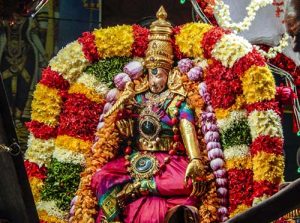 Festivals: A Carnival of Devotion
Festivals: A Carnival of Devotion
Every year at the temple, many festivals are celebrated, adding uniqueness to the city’s cultural landscape. Among the numerous festivals, the most popular is the Meenakshi Tirukalyanam—the divine wedding of Meenakshi and Sundareswarar. Observed in the Tamil month of Chithirai, which is usually in April, the festival brings a splash of colours to the temple city, attracting over a million pilgrims every year. The festive procession of the gods around the temple, accompanied by music and dance, is the cultural gem of Tamil Nadu. Other festivals such as the “Avani Moola Utsavam” and “Navarathri” depict the role of the temple in the propagation of local habits and crafts.
Why Visit Meenakshi Temple
Take a journey through time, where you see a window into the spiritual and cultural heritage of India. For the faithful, it is a site for prayer and blessings and for the historian and the lover of the arts, the temple is a breathtaking showcase of sculpture, painting, and architectural form that speaks to its heritage.
Every corner of this temple complex tells you a story, every sculpture holds a myth, and every festival brings alive the traditions passed down through millennia. From the gentle dance of light and shadow in the Thousand-Pillar Hall or the still waters of the Golden Lotus Pond reflecting the gopuras, the Meenakshi Temple is a witness to Tamil culture’s rich heritage and abiding legacy.
Conclusion
Madurai, often referred to as the “Athens of the East,” or “Temple City”, celebrates Tamil culture at its most vibrant. Meenakshi Temple is an important part of this historical city. As a representation of spirituality and tradition, a visit to the temple offers new perspective. Visiting Madurai and the Meenakshi Temple provides an unparalleled glimpse into the depth of India’s religious practices, its community’s way of life as you walk through the bustling streets of Madurai, taking in the aroma of jasmine and the sound of temple bells fill the air.
Come and partake in the rituals and have an enriching experience. It a must-visit destination for anyone traveling to India.
